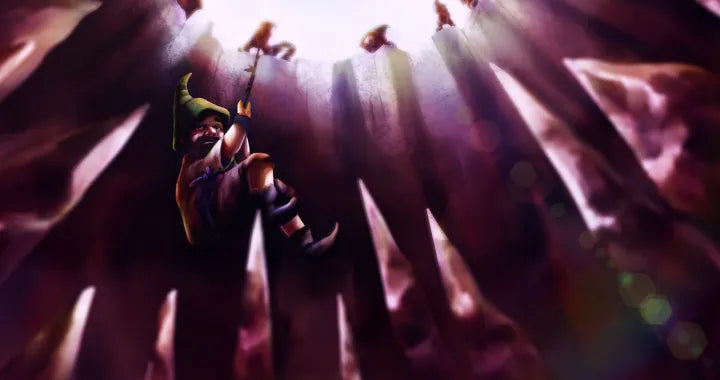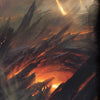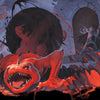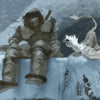5 Free RPG Traps

By Dave Owens
Water I do?!
Mechanical trap (Complex trap, level 11-15, dangerous)
Description. This trap aims to separate groups of intruders and whittle their numbers down through nefarious force. It appears as a short, 10-foot-wide hallway leading to an arched entryway. The entryway is open, 5 feet long, 10 feet tall, and 8 inches thick, with two seams stretching across the top beam. It has a 6-inch wide, 2-inch-deep cavity on each side. Some form of concealment of the game master’s choice lines the floor wall-to-wall, but the hallway is otherwise empty. The ceiling is slightly cracked and damp, with an occasional drip.
The roof and floor of the hallway have thin, nearly imperceptible seams around the ceiling and floor, as both pieces have a mobile capability. Above the hallway is a long shaft filled with thousands of gallons of water, enough to drip through the ceiling but not enough to push the disconnected ceiling down (yet). Above the water line is a mechanism that will eventually feed more water into the shaft, be it a mechanism or a waterfall, GM’s choice. Below the hallway is an 80-foot-drop into a spiked pit.
Trigger. A pressure plate in the center of the hallway.
Initiative. All effects of this trap occur on initiative count 20. They occur in the following order: ceiling, floor, then spike pit.
Elements of the Trap
The Entryway. When the pressure plate is depressed for the first time, a 6-inch-thick steel door drops through the seam in the entryway, sealing off the exit.
The Ceiling. The ceiling is initially 12 feet high. Every round the trap is active, the ceiling descends by 1 foot. Whenever the pressure plate is in the down position on initiative count 20, water pours onto the ceiling, increasing the speed it lowers by 1 foot. Characters may attempt a Strength (Athletics) check to hold the ceiling in place. The DC is equal to 14 plus one-half the number of feet the ceiling has descended rounded up. Characters who succeed on this check by 4 or more force the ceiling 1 foot upwards. At certain heights, creatures of certain sizes take damage at the start of their turn from the pressure of the ceiling. The starting damage for all creatures is 5 (2d8) bludgeoning damage. Once the ceiling descends 15 feet, a winch hidden in the walls pulls it back up to its original height.
| Creature Size | Ceiling Height Where Damage Begins |
| Large | 4 feet |
| Medium | 2 feet |
| Small | 1 foot |
The Floor. Whenever the pressure plate is in the up position on initiative count 20, the floor slides 2 feet towards the arched entryway, revealing the open pit below. After 3 rounds with the trap starting with the pressure plate in the up position, the pressure plate itself slips into the wall under the false door, out of reach. Once the pressure plate recedes into the wall, it is permanently fixed in the up position. The floor completely disappears after five rounds of movement.
The floor may eventually recede to the point that two creatures are forced to share the same space. Any creature forced to end its turn in another creature’s space must succeed on a DC 14 Strength or Dexterity saving throw or fall off the floor into the 80-foot-deep shaft below. On a success, the creature remains in that space, but all creatures (including itself) sharing that space will have disadvantage on skill checks and Dexterity saving throws until the end of that creature’s next turn. If three creatures are ever forced to occupy the same space, the last creature to enter that space automatically fails its saving throw.
Spike Pit. Underneath the floor is an 80-foot-drop into a dark shaft with a spiked pit at the bottom. Any creatures that fall into the pit take 11 (2d10) piercing damage from the spikes, in addition to 28 (8d6) bludgeoning damage from falling. A successful DC 18 Dexterity (Acrobatics) check reduces the falling damage by half but doesn't affect the piercing damage from the spikes.
Countermeasures
Discovering the Trap. A successful DC 18 Wisdom (Perception) check spots the seams and concavities in the entranceway, as well as spots the fine seams around the ceiling and floor. A successful DC 15 Intelligence (Investigation) check on the floor discovers the pressure plate, but a result of 5 or lower triggers the trap.
Dismantling the Trap. Any character that wedges an object under the plate before activation prevents it from activating at all.
Escaping the Trap. The iron door can be lifted with a DC 20 Strength (Athletics) check from either side of the door. Alternatively, creatures that fall into the spike pit may attempt to climb out. A successful DC 15 Strength (Athletics) check allows the character to climb out the top of the pit. A failure causes the character to fall back into the pit after climbing halfway up, taking 6 (1d10) piercing damage and 14 (4d6) bludgeoning damage from the fall. Climbing the walls is trivial if at least 50 feet of rope are lowered into the pit and anchored to something at the top.
Venus Fungi
Dungeon hazard (Simple trap, level 1-4, setback)
Description. Native to tropical bogs and caves where standing water is prevalent, these fleshy fungi, known as five-fingered weli, pose a delicious temptation for the road-weary and alchemically curious. Its robust, peach-colored stem ranges from 6 inches to 1 foot in height, and from its center, five cream-white tendrils curl and twist to a full height of 3 to 5 feet tall, resembling a hand pinched at the fingertips. Luminescent sapphire pustules bulge from the tendrils in irregular configurations, occasionally bursting from an abundance of fragrant, cherry-scented sap.
Trigger. The five-fingered weli has two distinct triggers: when a creature or object touches it and when a creature consumes it.
Effect. When a creature touches the fungus, it attempts to grapple the creature. The weli has a +3 bonus to Strength (Athletics) checks. If successful, the grappled creature takes 1d6 acid damage per round while it remains grappled, and each round, the object or creature is pulled towards the weli’s beak at the top of its stalk. After 1d2 rounds, the weli’s beak is in range to attack the grappled creature. The beak has a +5 to hit and deals 1d8 slashing damage.
Consumed. The weli has a very inviting smell, and when roasted, it has a texture and flavor similar to buffalo. Six hours after a creature consumes the flesh of the weli’s tendril or stalk, they are considered poisoned.
Countermeasures
Identification. A DC 15 Intelligence (Nature) check reveals the weli’s predatory nature, and grants the character the knowledge of how to harvest portions of the fungus without triggering its grapple. If they or another character uses this information, they may attempt a DC 13 Wisdom (Survival) check at advantage to do so. With an Intelligence (Nature) check of 5 or below, the character confuses the weli for a similarly delicious but harmless fungus called giant pinch weed.
Escaping the Grapple. Every round, a character may reattempt to escape from the grapple. In addition, the weli’s tendrils can be sliced off and rendered immobile with an attack (AC 10 and 5 hp to destroy it) or a successful DC 10 Wisdom (Survival) check. However, so long as the weli has free tendrils still connected to its stalk, it will attempt to grapple the attacking creature(s) or their weapons should they be within melee range. The weli is immune to psychic damage.
Killing the weli. Cutting the weli through at the stalk kills the organism. The stalk has an AC of 12, 10 hp, and is immune to any attack that deals less than 8 damage.
Resisting the Poison. After a long or short rest, the poisoned creature may attempt a DC 14 Constitution check, removing the poison condition on a success. Alternatively, after 24 hours, the condition runs its course and is automatically removed.
Teensy Tunnel
Mechanical/magical trap (Simple trap, level 1-4, dangerous)
Description. Created by a hermit mage who needed an easier way to hunt, this arched, botanical tunnel, complete with tamped down underbrush and a shady, arboreal canopy, could be a deceptively convenient escape route for creatures hoping to leave whatever forest or jungle they’ve been exploring.
The forest-side entrance is 60 feet high and 20 feet wide and appears to be about 180 feet long. In reality, the tunnel is only 90 feet long, but its exit is much smaller than the entrance (20 feet height by 5 feet wide), so its length appears much longer than it actually is.
Trigger. This trap has three distinct triggers:
- Forward or backward movement through the tunnel
- Being size Tiny or smaller while inside the tunnel
- Stepping on one of the tree spring noose traps
Effects of the Trap
Forward Movement. Each tree lining the tunnel is carved with subtle runes that activate when registering specific directional movement in front of it. Creatures and everything they are carrying decrease in size by one category for every 30 feet they move towards the exit of the tunnel (a Medium creature becomes Small after moving 30 feet toward the exit) to a minimum size of Tiny. Each decrease in size reduces the creature’s weapon attack damage by 1d4, gives a -1 penalty to Strength checks, and decreases their speed by 10 feet.
Backward Movement. Creatures and everything they are carrying increase in size by one category for every 30 feet they move toward the entrance to the tunnel (a Small creature becomes Medium after moving 30 feet towards the entrance) to a maximum size of Huge. Each change increases the creature’s weapon attack damage by 1d4, gives a +1 bonus to Strength checks, and increases their speed by 10 feet.
Tiny or Smaller Creatures. Three swarms of ravens and three swarms of insects ambush any Tiny or smaller creature, whether there are larger creatures around or not.
Tree Spring Noose Traps. In the last 30 feet of the tunnel, 12 tree spring noose traps are scattered and concealed by the underbrush. The traps snare their targets and pull them 5 feet into the air when stepped on. The target is considered both grappled and restrained.
Countermeasures
Size Change. There are multiple ways to avoid the size-changing effects and their detriments. Moving laterally, vertically, or by teleportation does not trigger the size change effect. Due to the path shrinking at the same rate as the creature, it takes a successful DC 15 Wisdom (Perception) check to recognize the change in size. This realization is automatic once ambushed. The size change effect can also be detected by detect magic, dispelled by dispel magic, and is immediately dispelled whenever a creature leaves the tunnel by either the forest entrance or the exit.
Tree Spring Noose Traps. These traps can be spotted with a DC 13 Wisdom (Perception) or a DC 11 Intelligence (Investigation) check. They can be disarmed with a DC 12 Dexterity check (DC 10 with Thieves’ Tools). If the trap is sprung, a creature may avoid being snared by succeeding on a DC 14 Dexterity saving throw. Once caught, the noose can be loosened by a DC 15 Strength check or dismantled with a DC 12 Dexterity (Sleight of Hand) check, made with advantage if using Thieves’ Tools.
Crumbled Coffin
Magical trap (Simple, level 5-10, setback)
Description. This double pit trap utilizes magic, engineering, and a very large boulder to imprison intruders. The first pit is 20 feet deep and 10 feet in diameter, with a large pocket dug out of one side. That pocket holds a massive boulder, kept in place by four jointed wooden beams. The beams leave a clear path from the top of the pit to the bottom, where a glyph of warding with a stored 3rd-level shatter spell has been placed across a 5-foot-radius portion of the floor. Beneath that glyph is a second cylindrical pit 10 feet deep and 5 feet in wide.
Trigger. This trap has two triggers: when a creature steps on the first pit and when a creature lands on the glyph of warding above the second.
Effect. When a creature steps on top of the first pit, the false floor caves in and drops the creature 20 feet, dealing the appropriate amount of falling damage. If the creature lands on the glyph of warding, it activates, casting shatter at 3rd-level (spell save DC 13) on the center point of the pit floor. Affected creatures then fall 10 feet into the second pit. The wooden supports holding the 5 feet diameter boulder in place are instantly destroyed, releasing the boulder from its pocket where it falls on top of the mouth of the second pit, sealing whatever creature(s) have fallen inside. Finally, the creators of this trap are alerted to the trap’s activation by the sound of the shatter spell.
Countermeasures. The first pit can be discovered with a successful DC 11 Intelligence (Investigation) check. Upon triggering the first pit, a successful DC 12 Dexterity saving throw allows the character to avoid falling inside. While falling into the first pit, a character may use one reaction or bonus action to attempt to prevent the fall. Characters who investigate the floor and succeed on a DC 10 Intelligence (Investigation) check, they can identify the presence of the glyph of warding. Once triggered, the character may attempt a DC 14 Dexterity or Strength saving throw to scramble out of the second pit before the boulder falls and seals it. Once the boulder falls into place, a DC 20 Strength (Athletics) check is required to push or pull it out of the way.
The Triple Whip
Mechanical trap (Simple, level 5-10, dangerous)
Description. This trap bets on dexterous prey and hopes to catch them off guard by throwing triple than what they expect. A ground-level tripwire releases the first of three elastic branches, armed with a crown of five poisoned spikes, to whip from behind a camouflaging obstruction or structure (like a tunnel’s corner or a tree) and stab into the victim’s gut, back, and chest. If the victim can dodge the assault, the spikes instead sever a vertical tripwire behind the victim, releasing a second spiked branch from above and behind them. Finally, should the victim dodge this branch, it severs an aerial tripwire, launching a third and final spiked branch horizontally from the opposite side as the first.
Trigger. Setting off any of the three tripwires will launch at least one spiked branch, but the number of potential attacks depends on which wire is tripped first. The horizontal ground wire delivers three potential attacks, the vertical wire to the right delivers two potential attacks, and the horizontal hovering wire (8 feet in the air) delivers only one. If a creature is hit by one of these attacks while potential attacks remain, the trap becomes inactive until an additional primed tripwire is triggered.
Effect. Each branch’s crown of spikes has a +7 bonus to attack rolls. They deal 13 (5d4) piercing damage on a hit. Additionally, the target must succeed on a DC 11 Constitution saving throw, taking 11 (3d6) poison damage on a failure.
Countermeasures. This trap can be spotted with a DC 15 Wisdom (Perception) check or a DC 12 Intelligence (Investigation) check. Investigation checks that fail by 5 or more trigger the trap. Any of the three tripwires can be disarmed with a DC 15 Dexterity (Thieves’ Tools) check, and failing by 5 or more triggers the trap. Whenever a branch misses its target, the targeted creature may make a DC 13 Wisdom (Perception) check. On a success, the creature identifies subtle clues about the trap’s design and gains a +2 bonus to their AC against the traps remaining effects. Other members of the target’s party may assist by disrupting the trap physically and/or magically, or by succeeding on a DC 15 Wisdom (Perception) check to spot the tripwires and inform the target of the incoming strikes.
-
Posted in
Traps






